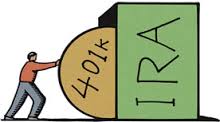
This week on the Retire With More Show my good friend, Harvard Business School classmate and business partner Scott Puritz joined us. Scott is Managing Director at Rebalance. One of the things he is passionate about, which he encounters quite a bit in his side of the business, is best practices among people as they change jobs, such as making sure to roll over their company 401(k) into an individual IRA.
Think about it: What money do you have out there from an old job? Who are the beneficiaries on that account? If you don’t know, you ought to. How is it being managed? Is it being managed with your future goals in mind? If not, you’re leaving money on the table.
If you fall into this category, you might be asking yourself, “How do I track down these stranded accounts and then roll them over?” At Rebalance, what we do with a prospective client that has stranded 401(k)s is find where the money is first. Then we help the client open up a rollover IRA account with one of our custodial partners, either Fidelity or Schwab, and request that the money be transferred.
“Once it’s in one spot, under our client’s complete control, then we can go and do our job of managing it properly, reducing fees and getting the money working harder. We have a phrase for it around the office, jokingly, ‘It’s your money, take it with you, damnit!’” — Scott Puritz
anxiety down, sense of control up
Retirement account consolidation equals anxiety down and a sense of control up. When you have a 401(k) with an employer, it’s not under your control. By rolling it over into a rollover IRA that is in your name, however, you control it for the rest of your life and you have access to any investment choice that you want. If it stays in an old 401(k), you don’t.
“If you move your company 401(k) over to a platform like Fidelity or Schwab in your name, you get full control of your hard-earned retirement savings and you get the full range of investment options. Should you go with low-cost index funds? Do you want the ability to be able to rebalance your portfolio on a regular basis, or revisit what you have and who your beneficiaries are? When you are in control you are able to really plan and be sensible so that at the end of the road, when it comes to retire, you can retire with more.” — Scott Puritz
If you take all of the 401(k) money that you have accumulated from all of your jobs and you roll it into your own IRA, it’s all in one place. If you have a variety of amounts, they all get added up into one large sum in one account. The greatest advantage of retirement account consolidation is the ability to lower your fees and better manage your retirement savings.
“When we talk about the power of long-term compounding working in your favor to grow your retirement savings over time, in a similar sense fees and expenses compound and grow to eat up a lot of a potential retirement portfolio. One percent (1%) of fees under normal scenario can eat up almost a third of a retirement saver’s total return, going out 25 years.” — Scott Puritz
When you have money in 401(k) plans you are paying money in fees for the administration of the plan, and those plans are not cheap. If your money is in an IRA however, you have a broad range of choices and you can get your fees down to rock-bottom.
tax-free
If properly implemented, a company 401(k) rollover is done on a tax-free basis. It moves from one tax-sheltered account at your former employer into another account in your name that you can control and there are zero tax implications for decades. The service that Rebalance provides steers you through this obstacle course so that you can avoid making a mistake, which could result in being taxed and possibly penalties on top.
“You could do it yourself, although there are a couple of steps along the way. Sometimes, particularly in large employers and insurance companies, these steps are difficult and you certainly can make a mistake, and the financial tax implications would be quite profound.” — Scott Puritz
We spend a considerable amount of time with our clients up front getting to know them and their attitudes towards risk. We survey all of the family balance sheet and financial assets and then take a holistic view, making a recommendation on one of our proprietary retirement portfolios best suited not only for the client in front of us but their whole family.
“As people age, the complexities of their life and the financial complexities of their life go up. In order to retire with more, you have to think about everything you are bringing in, everything you are saving and how you are spending it. When we get to know our clients and the full picture, it really makes it easier to provide substantial value-added advice.” — Scott Puritz
Make sure you tune in live next week to Retire With More. Join me and John Rothmann Saturdays at 9 a.m. on KKSF Talk 910.





